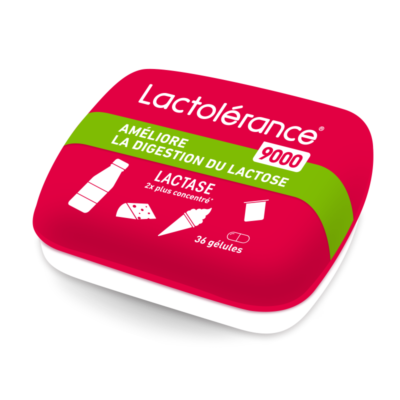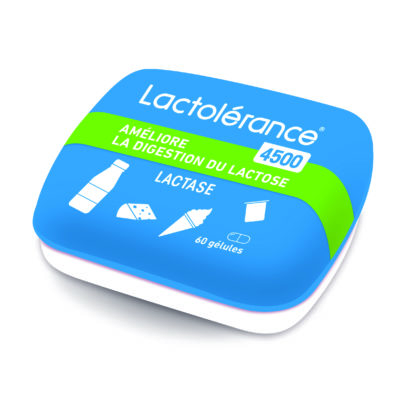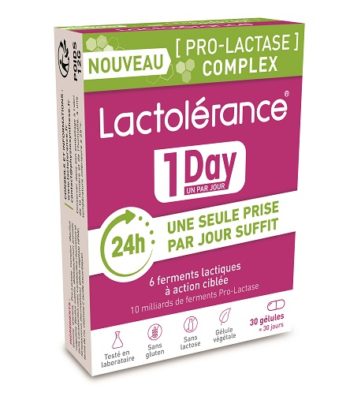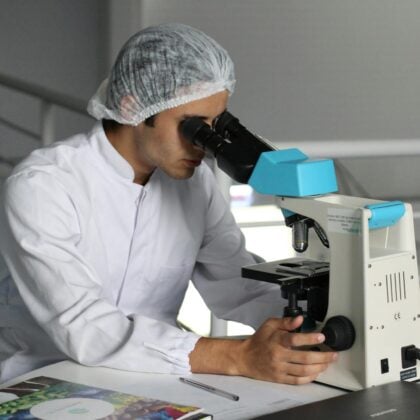
What to remember :
Although lactose intolerance is hereditary and irreversible (it affects the majority of the world's population), certain accidental causes (illnesses or medical treatments) can provoke, accelerate or aggravate it.
In all cases, the symptoms are the same after consuming lactose products, and different treatments for these symptoms can help people with lactose intolerance.
1. The hereditary origin of lactose intolerance
2. Accidental causes of lactose intolerance
3. Treatment of the symptoms of lactose intolerance
1. The hereditary origin of lactose intolerance: primary alactasia
It is estimated that 65% of the world's population are now lactose intolerant after childhood, corresponding to the ancestral phenotype "Non Persistent Lactose" (LNP).
Gold this lactose intolerance is original to all mammalswhich consume only their mother's milk until they are weaned (lactose being the main energy nutrient for infants), and then stop producing the lactase enzyme needed to dissociate lactose in the small intestine, an operation that is essential for lactose digestion. Lactose intolerance therefore affected 100% of adult humanity before the Neolithic period.
It was at this time (around 8,000 BC in the Near East, then in Europe) that some of our hunter-gatherer ancestors became sedentary, becoming livestock farmers, and began to consume dairy products from their herds (goats, sheep and cows).

Some desert Bedouins with a nomadic lifestyle consumed milk from their livestock (goats, sheep and camels) in Africa or Jordan.
These populations, becoming accustomed, in adulthood, to consuming milk and dairy products, rich in animal proteins, but also in vitamins, have thus developed a derivative characters, the Lactose Persistent (LP) phenotypeThis has been passed on to their descendants, who today represent about 35% of the world's population - a large geographical disparity:
- while the proportion of LPs (individuals able to digest lactose as adults) may exceed 90% in the British Isles and Scandinavia, or among the nomadic Fulani of Niger,
- However, this proportion is reversed in Southeast Asia, where LNP (lactose intolerant) constitute the vast majority of the population.
Lactose intolerance, which is originally the natural norm in all mammals (this is why it is called primary alactasia), is therefore an ancestral hereditary trait affecting the majority of humansThis leads to the cessation of the production of the enzyme lactase (which digests the lactose in milk) after weaning.
Lactose intolerance is incurable and irreversible: existing solutions, such as lactase enzyme supplementation, can only treat the symptoms, not 'cure' their cause - since it is not a disease!
2. Accidental causes of lactose intolerance: secondary alactasia
If lactose intolerance is therefore hereditary (it is theprimary alactasia), some accidental factors can however trigger it, accelerate it or aggravate it: we speak then ofsecondary alactasia (not hereditary).
It is important to know that the enzyme lactase, which allows the digestion of milk lactose (complex milk sugar, dioside or disaccharide) by dissociating it, by hydrolysis, into simple sugars (glucose + galactose), is secreted in LP individuals in the small intestineThis is the longest part of the intestines (about 6 metres). It is the longest part of the intestines (about 6 metres), and it is here that the intestinal absorption of nutrients takes place, a crucial phase of digestion.
However, the wall of the intestines is not smooth: it is made up of tiny folds of intestinal mucous membrane, known as villi "These are used to extend the surface area of contact with ingested food and thus amplify the absorption phenomenon.

It is precisely at the top of the villi that lactase is secreted, in an area called the "brush border".
In LNP individuals, who no longer secrete (or sufficiently secrete) lactase, the lactose is no longer broken down by the dedicated enzyme and is then (poorly) digested by intestinal bacteria, which produce gases (H2 and CO2), which in turn cause the typical symptoms of lactose intolerance, such as bloating, borborygma and diarrhoea.
Certain infections or intestinal diseases attack this intestinal mucosa and destroy the villi, which can no longer produce lactase.
This leads to significant digestive problems, as nutrients are poorly (or no longer) absorbed by the body. This is the case with inflammatory bowel diseases such as Crohn's disease or rectocolitis, but also with undiagnosed gluten intolerance, where the intestinal mucosa is damaged if the affected individual continues to take in gluten.
These digestive problems are often temporary and the mucosa regenerates when the disease in question is cured or the gluten intolerant person stops consuming gluten.
The " tourista "or "traveller's diarrhoea", which is well known to tourists in some African countries, and which is a gastroenteritis sometimes acute, manifesting itself by symptoms also known to lactose intolerant people (notably abdominal pain and cramps, diarrhoea), is of bacterial, parasitic or viral origin.
Generally benignHowever, it is sometimes accompanied by serious intestinal complications which, by irritating the intestinal wall, can lead to secondary alactasia (lactose intolerance), either temporary or long-lasting, thus aggravating and accelerating the cessation of lactase production in people who belonged to the LP phenotype before their trip... and who return from it lactose intolerant!

Certain medical treatments, such as the prolonged use of antibiotics, can disrupt the functioning of the intestinal villi and lead to lactose intolerance.
Chemotherapy/radiotherapy (which sometimes cause damage to the lining of the intestine), attacks the integrity of the intestinal mucosa, which is thus affected, is no longer able to produce the enzyme lactase in sufficient quantities. As the lactose is no longer synthesised by the necessary enzyme, the symptoms of lactose intolerance arise, leading to a characteristic and embarrassing digestive discomfort.
Removal of part of the small intestineIn addition, the production of the enzyme lactase by the body can be reduced by surgery for certain cancers. The effects are then similar to the symptoms of lactose intolerance.
3. Treatment of the symptoms of lactose intolerance
Whether it is primary alactasia (hereditary lactose intolerance affecting about 65% of humans) or secondary alactasia (lactase enzyme deficiency caused by intestinal disease or infection, other food intolerance, or medical treatments), the result is always the same Lactose intolerance: the body's failure to produce lactase leads to the typical symptoms of lactose intolerance:
- digestive discomfort,
- stomach ache,
- borborygms or gurgles,
- abdominal swelling,
- Heartburn,
- gastric acidity and gastro-oesophageal reflux,
- abdominal cramps,
- bloating,
- flatulence,
- diarrhoea,
- possibly nausea, vomiting
These symptoms can vary depending on the amount of lactose ingested (sometimes a small amount is enough), and the severity of the individual's lactose intolerance.
In response to these symptoms, different dietary strategies can be considered:
To do this, it is necessary to favour dairy products containing only traces of it (mature cheeses, home-made yoghurts);
It is not only a question of eliminating all dairy products and replacing them with lactose-free dairy products, for example, or with vegetable substitutes (soya or oat milk), - it is also necessary to scrutinise all labels very carefully and systematically inform oneself about the composition of what one eats, in order to detect hidden lactose (in cold meats and ready-made meals as a texturising agent and preservative, in certain medicines as an excipient, etc.);
A solution to be able to eat serenely without being obsessed by the traps of the food industry, nor anxious about the risks of each and every one of them.
This is what the of food supplements LACTOLERANCEin 2 distinct formulas:


They provide you directly, in capsule form, with the lactase that your body does not produce in sufficient quantities (concentration 4500) - or not at all (concentration 9000).
To be taken at the beginning of a meal or just before consuming a product containing lactose, lactase capsules Lactolerance The capsules are totally and instantly effective. They can be dosed (1 to 2) according to the severity of your intolerance and the quantity of lactose to be absorbed, and their effectiveness lasts from 45 minutes to 1 hour.
Available in a small box (pillbox) or in an economy bottle, Lactolérance 4500 and Lactolérance 9000 will follow you wherever you go, in your pocket or in your bag.

Based on the principle of probiotics, this is the most innovative solution for improving lactose digestion and combating the symptoms of lactose intolerance, since one capsule per day is sufficient. Its original combination of lactic ferments provokes the production of lactase in the small intestineIf you suffer from lactose intolerance, discontinue the product.
Designed for all degrees of lactose intolerance, mild to severe, Lactolérance 1Day is already effective after one week and reaches its maximum effectiveness after 6 weeks of daily use. No need to take it with you: your capsule is waiting for you at home!
Do not hesitate to talk to your doctor, gastroenterologist or dietician.

Hello, I'm Vincent
Like you, I'm lactose intolerantI know exactly what you're going through and the difficulties you encounter on a daily basis. For over 10 years, I've been helping our customers to use our dietary supplements and giving advice and tips on how to improve their digestive comfort. I'm also a keen cook and gourmet, so you'll find my favourite recipes for a lactose-free diet in this blog.
Lactose intolerance is not inevitable! With LACTOLERANCE you can digest with complete peace of mind






